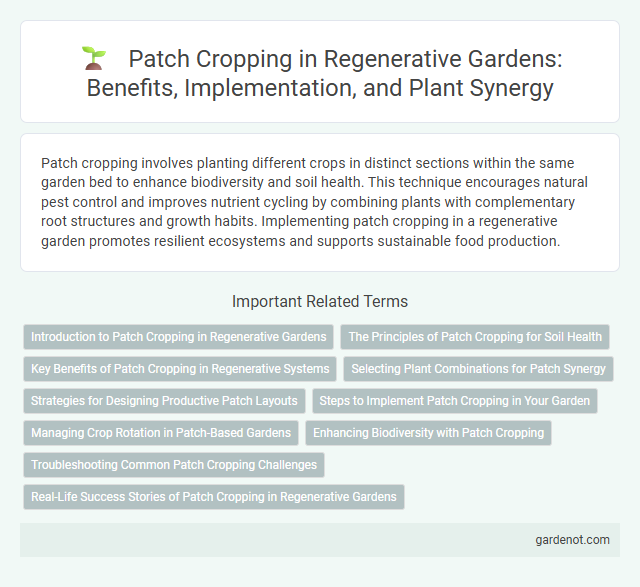Patch cropping involves planting different crops in distinct sections within the same garden bed to enhance biodiversity and soil health. This technique encourages natural pest control and improves nutrient cycling by combining plants with complementary root structures and growth habits. Implementing patch cropping in a regenerative garden promotes resilient ecosystems and supports sustainable food production.
Introduction to Patch Cropping in Regenerative Gardens
Patch cropping in regenerative gardens involves dividing planting areas into distinct sections to optimize biodiversity and soil health. Each patch can support different plant species and microhabitats, promoting natural pest control and nutrient cycling. This technique enhances ecosystem resilience by mimicking natural plant patterns and improving water retention in garden soils.
The Principles of Patch Cropping for Soil Health
Patch cropping involves alternating strips of different crops to enhance soil structure and nutrient cycling. This practice reduces erosion, increases organic matter, and promotes biodiversity, which improves soil resilience and fertility. Implementing diversified crop patterns in patch cropping supports microbial activity and optimizes water retention essential for regenerative garden soil health.
Key Benefits of Patch Cropping in Regenerative Systems
Patch cropping enhances soil health by promoting biodiversity, which supports beneficial microorganisms and improves nutrient cycling in regenerative systems. This practice reduces erosion and water runoff by maintaining ground cover and root structures in varying crop patches. Increased crop resilience and pest management efficiency result from the spatial diversity, contributing to sustainable productivity in regenerative agriculture.
Selecting Plant Combinations for Patch Synergy
Selecting plant combinations for patch cropping in regenerative gardens enhances soil health, pest control, and biodiversity by leveraging complementary root structures and nutrient needs. Integrating legumes with deep-rooted grasses boosts nitrogen fixation and improves soil aeration, fostering a resilient ecosystem. Strategic pairing of flowering plants attracts beneficial pollinators, increasing overall garden productivity and sustainability.
Strategies for Designing Productive Patch Layouts
Patch cropping leverages spatial diversity by planting different crops in distinct patches to improve soil health, increase biodiversity, and optimize resource use. Designing productive patch layouts involves selecting complementary crop species with varying root depths and nutrient needs to minimize competition and maximize soil nutrient cycling. Strategic positioning considers sun exposure, wind patterns, and soil moisture variability to enhance growth conditions and promote resilience in regenerative gardens.
Steps to Implement Patch Cropping in Your Garden
Start patch cropping by dividing your garden into small, manageable sections, selecting diverse crops that complement each other to enhance biodiversity and soil health. Prepare each patch by enriching the soil with organic matter and creating microhabitats to support beneficial insects and pollinators. Regularly monitor growth and adjust planting strategies to optimize nutrient use, pest control, and overall garden productivity.
Managing Crop Rotation in Patch-Based Gardens
Patch cropping enhances soil health by strategically managing crop rotation within segmented garden areas, promoting biodiversity and minimizing pest buildup. Implementing diverse crop families in adjacent patches interrupts pest and disease cycles while optimizing nutrient cycling for sustainable growth. This practice supports regenerative principles by improving soil organic matter and moisture retention across patch-based gardens.
Enhancing Biodiversity with Patch Cropping
Patch cropping enhances biodiversity by creating diverse microhabitats within a regenerative garden, supporting various plant and insect species. This method increases soil health through varied root structures and organic matter, promoting beneficial microbial activity. Implementing patch cropping reduces pest outbreaks naturally by encouraging predator populations and disrupting monoculture patterns.
Troubleshooting Common Patch Cropping Challenges
Patch cropping often faces challenges such as uneven nutrient distribution and pest infestations that hinder plant growth. Implementing soil testing and targeted organic amendments can correct nutrient imbalances effectively. Incorporating beneficial insects and ensuring crop diversity promote pest control and resilience in regenerative garden systems.
Real-Life Success Stories of Patch Cropping in Regenerative Gardens
Patch cropping in regenerative gardens has demonstrated significant improvements in soil health and biodiversity through diverse crop placement, as seen in numerous farms across the Midwest and Southeast United States. Real-life success stories highlight higher yields and reduced pest pressure, with farmers reporting up to 30% increases in crop productivity and enhanced resilience against drought conditions. The integration of legumes, grasses, and vegetable patches in strategic spatial arrangements fosters natural nutrient cycling, which accelerates soil regeneration and carbon sequestration.
Patch cropping Infographic

 gardenot.com
gardenot.com